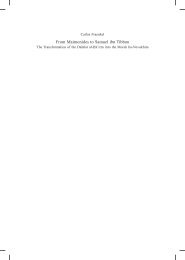Download PDF - Carlos F. Fraenkel
Download PDF - Carlos F. Fraenkel
Download PDF - Carlos F. Fraenkel
You also want an ePaper? Increase the reach of your titles
YUMPU automatically turns print PDFs into web optimized ePapers that Google loves.
concept and history of philosophical religions 71Spinoza here makes the exact same claim that defines Averroes’ stanceon the relationship of philosophy and Islam: “veritas veritati non repugnat.”The problem I am interested in is this: In his critique of religionSpinoza develops an exegetical method by which he intends to showthat Scripture contains no truth and, therefore, cannot interfere withphilosophy. 137 Whereas philosophy determines what is true and false,religion based on Scripture secures obedience to the law. 138 On the otherhand, there are a significant number of passages throughout Spinoza’swork—from the Metaphysical Thoughts to the Ethics and the late correspondencewith Oldenburg—in which he attributes a true core to Scripture,often presented as its allegorical content. The main thesis for which Iwill argue is that this inconsistency is best explained by assuming thatSpinoza is committed to two projects that he ultimately was unable toreconcile: he wants to use religion as the handmaid of philosophy thatprovides the basis for the best life accessible to nonphilosophers andhe wants to refute religion’s claim to truth in order to defend what hecalls the “freedom to philosophize (libertas philosophandi ).” 139 Spinoza’scritique of religion was, of course, momentous. He argued that we haveno good reason to take for granted what everyone committed to a religionbased on Scripture must assume: that the content of Scripture istrue—whether this truth is taken to coincide with scientific knowledgeand derived from the intellectual perfection of the religion’s founder orwhether it is taken to be above scientific knowledge and derived from amiraculous act of divine revelation. Both positions stand and fall withthe assumption of Scripture’s truth. After suspending this assumptionat the beginning of his examination of Scripture, Spinoza proceeds inan analogous way to the scientist whose aim is to explain nature. Bothwork out a “history,” i.e., a methodical account, of the object of theirstudy. 140 For the Bible scholar this means collecting and ordering thedata contained in Scripture and then interpreting them in light of therelevant historical and socio-cultural contexts as well as the psychologicalpeculiarities of the prophets insofar as these can be reconstructedfrom the available sources. This is what Spinoza means by the claimthat “the knowledge of all the contents of Scripture must be sought137See in particular Spinoza 1925 TTP 7.138See in particular Spinoza 1925 TTP 12–15.139Spinoza 1925, see the subtitle of the TTP and Letter 30 in which Spinoza laysout the project of the TTP.140Spinoza 1925 TTP 7 vol. 3, 98; English 89.



